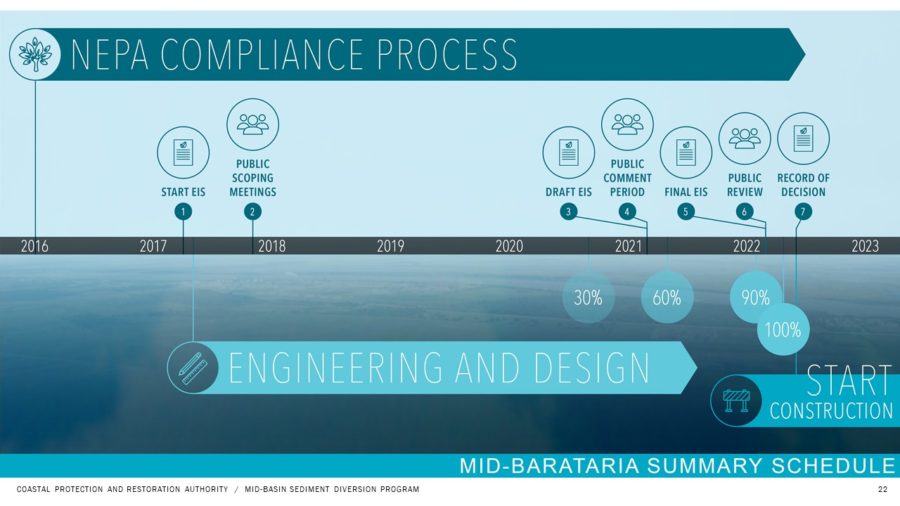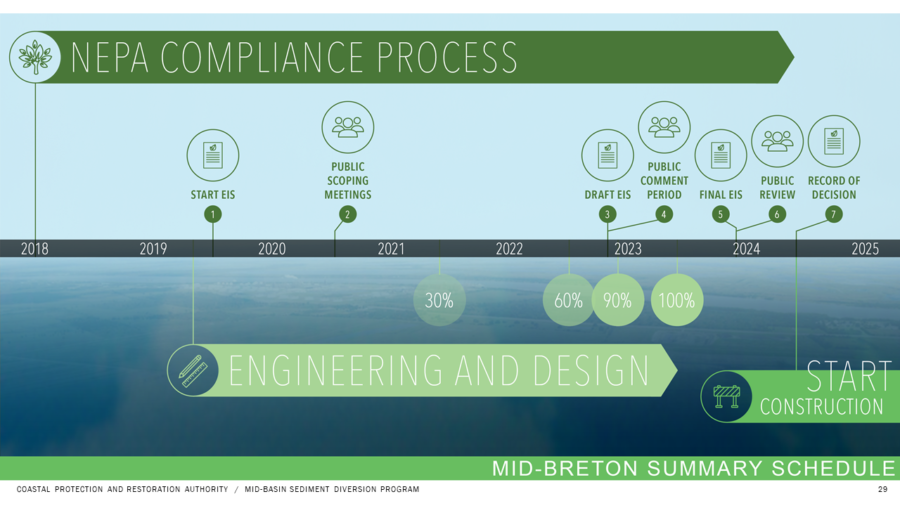Sign Up. Stay Informed.
- Overview
- Project Benefits
- Funding
- Sediment Diversions
- Timeline
- Resources / Get Involved
- Community Outreach
Timeline
Environmental Permitting
As a part of the environmental permitting process for the sediment diversion projects, CPRA (cooperating agency) works in coordination with the U.S. Army Corps of Engineers (lead agency) to submit an application for a permit to begin construction on the project.
The National Environmental Policy Act (NEPA) requires federal agencies to integrate environmental values into their decision-making processes by considering the environmental impacts of their proposed actions and reasonable alternatives to those actions.
A large portion of the evaluation of these projects includes an Environmental Impact Statement (EIS) – a detailed analysis that serves to ensure that the policies and goals defined in NEPA are consistent with ongoing programs and actions of the agencies involved in the project. The EIS will evaluate potential impacts on numerous factors including fisheries, socioeconomic, marine mammals, water quality, storm surge/flooding, and aesthetics of the environment, to ultimately inform the decision on project construction.
Based upon the results and impacts identified during the EIS process, CPRA will adjust project operations and implementation to avoid, minimize, or mitigate any significant impacts the projects may have. CPRA remains committed to transparency and full cooperation with all involved agencies and stakeholders during this process to implement the best project possible for the state of Louisiana and our coastline.
Engineering and Design
The program team works in tandem with the permitting process to optimize operations, formulate final project design, and supply any additional research or information required for appropriate permit applications.
Project materials for Mid-Barataria Sediment Diversion can be found here.
Project materials for Mid-Breton Sediment Diversion can be found here.
Timeline: Mid-Barataria
The EIS Process for Mid-Barataria is currently underway.
- June 2016: CPRA submitted an updated permit application to the New Orleans District of the U.S. Army Corps of Engineers.
- January 2017: CPRA selected Gulf Engineers and Consultants (GEC) as the third-party contractor to lead the EIS.
- July 2017: CPRA selected AECOM to lead engineering and design efforts.
- June 2018: CPRA selected Archer Western-Alberici Joint Venture to provide Construction Management At-Risk services for the project.
- Summer 2020: Draft EIS available for public comment.
- Late 2020: Final EIS available for public review.
- 2023: Record of decision on project implementation.
Timeline: Mid-Breton
- February 2018: CPRA selected Stantec Team to lead engineering and design efforts.
- March 2019: CPRA submitted a permit application to the New Orleans District of the U.S. Army Corps of Engineers.
- April 2019: CPRA selected the Louisiana Diversions Company (LDC) to provide Construction Management At-Risk services for the project.
- 2021: Draft EIS available for public comment.
- 2023: Final EIS available for public review.
- 2024: Record of decision on project implementation.


